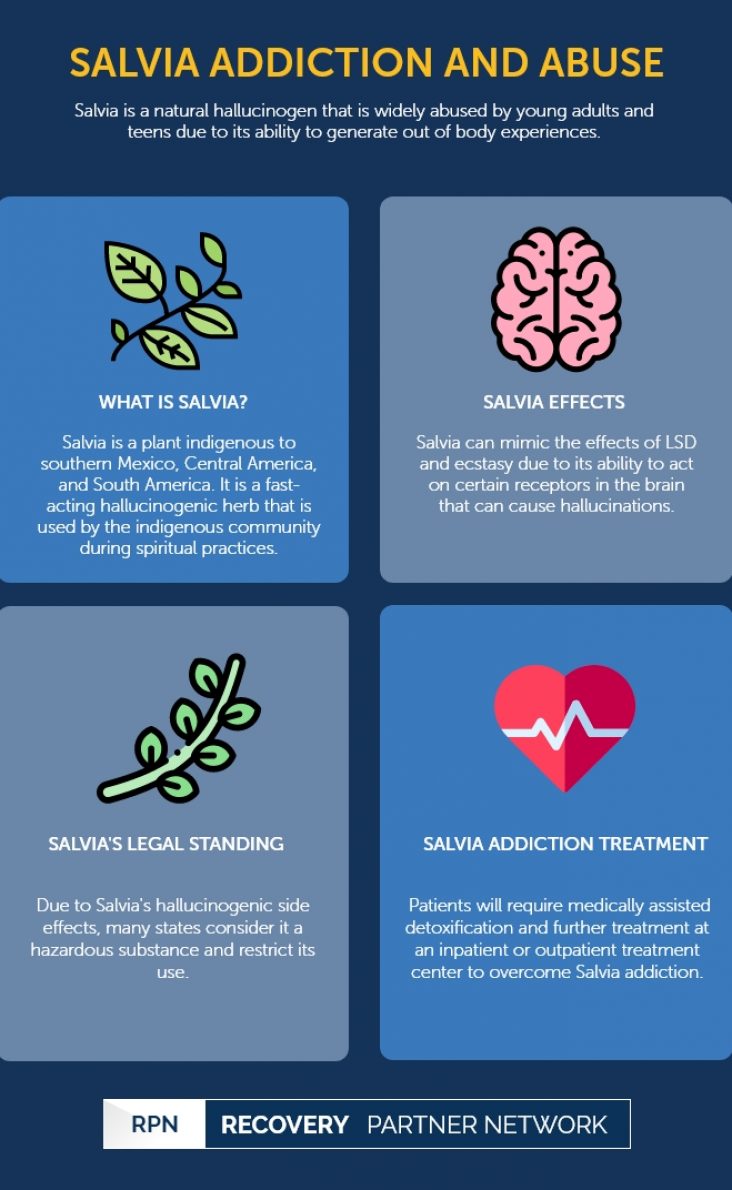Salvia is a natural hallucinogen that is widely abused by young adults and teens due to its ability to generate out of body experiences.
Salvia Addiction and Abuse
Illicit drugs
- Ayahuasca addiction – Abuse
- Baclofen addiction
- Black tar heroin addiction
- Cannabis addiction
- Cocaine dependence
- Crack cocaine addiction
- DMT addiction abuse treatment
- Does Marijuana Kill Brain Cells?
- Ecstasy addiction
- Gabapentin addiction
- gamma-Hydroxybutyric acid addiction
- Hallucinogen
- Heroin addiction
- Illicit drug addiction
- Inhalant addiction
- Cocaine
- Ketamine addiction
- Lysergic acid diethylamide addiction
- Mescaline addiction
- Methamphetamine addiction
- Meth Labs: Cooking up Addiction
- Meth Mouth
- Microdosing
- Phencyclidine addiction
- Psilocybin mushroom addiction
- Sage of the diviners – Addiction
- Shooting Heroin
- Shooting Methamphetamine
- Smoking Cannabis
- Speedball
- Synthetic cannabinoids
Sage of the diviners - Addiction | Table of Contents
What is Salvia?
Also known as Salvia Divinorum, it is a plant indigenous to southern Mexico, Central America, and South America. The plant belongs to the Lamiaceae family and consists of more than 800 varieties. Salvia plant has large green leaves with white or purple flowers that grow in large clusters that reach around three feet in height and contain a distinctive mint fragrance. It is a fast-acting hallucinogenic herb that is primarily used by the indigenous community during spiritual practices.
Other names of Salvia are:
- Maria Pastora
- Diviner’s Sage
- Shepherdess’ Herb
- Magic Mint
- The Female
- Diviner’s Mint
- Sage of the Seers
- Sally-D
Although Salvia is classified as a Schedule I Substance in certain states, it is legal for recreational consumption in others. Salvia is sold as leaves, seeds, or liquid extracts. This drug can be ingested through chewing or smoking. During smoking, the leaves are dried and smoked in pipes, similar to marijuana. Salvia has a high potential for misuse with no acknowledged medical use. It is a drug widely abused by young adults and teenagers.
FAQ
Salvia, known as Salvia divinorum, consists of big green leaves, hollow square stems, and white flowers.
Users often chew leaves fresh out of the plant, extract and drink the juices, or roll up the dried leaves into a joint that can be smoked. It can also be vaporized and inhaled in water pipes.
Salvia Effects
Salvia can mimic the effects of LSD and ecstasy due to its ability to act on certain receptors in the brain that can cause hallucinations. The effects are generated within minutes after consumption and usually last around 30 minutes. Users generally experience the most intense effects of the drug within 2 minutes of smoking and diminish within 20 minutes. Salvia can generate an altered sense of reality and self-awareness.
When Salvia is chewed, it releases its active chemical component known as salvinorin-A, which is absorbed into the oral mucosa. This method leads to visual hallucinations and altered states of cognition that can last for 1 to 2 hours. Liquid Salvia is usually consumed by mixing with other drinks. Another common way of using Salvia is by crushing the leaves and blending them with drinks or heated up and vaped.
The physiological and psychological effects of Salvia are:
- Loss of touch with reality
- Feeling of levitation
- Depersonalization
- Seeing vivid colors and unusual patterns
- Talkativeness
- Nausea
- Temperature changes in the body (chills)
- Slurred speech
- Uneasiness
- Dizziness
- Irregular heartbeat
- Uncontrollable laughter
In extreme cases, some individuals may experience psychotic side effects and trouble re-adjusting to reality after they have misused Salvia. When people combine Salvia with other substances, such as alcohol or stimulants, there is an elevated risk of an overdose.
Salvia Abuse and Dependence
Signs that may suggest abuse of Salvia include:
- Use of Salvia every day
- Problems at school, work, or home
- Secrecy and social isolation
- Polydrug abuse
- Eating disorders
- Falling asleep or being awake at odd times
- Mood swings and unpredictable behavior
- Lack of hygiene or no interest in physical appearance
- Increased injuries and accidents
- Personality and behavioral changes
- Getting involved in risky behaviors
- Difficulty in concentration and memory loss
- Consuming higher doses of the drug due to tolerance
Although there is no clear evidence that suggests Salvia can cause addiction, but like all hallucinogens, Salvia does possess a capacity to form psychological dependence on the user.
Salvia's Legal Standing
Due to Salvia’s hallucinogenic side effects, many states considered it hazardous and restricted its use. Those who are found consuming or in possession of Salvia in those states will be sentenced to five years in jail. Salvia is legal for recreational use in some US states, such as California and Maine. States like Missouri, Delaware, and Oklahoma have classified Salvia as a Schedule I Substance under the Controlled Substance Act. Tennessee has declared the possession of the plant to be a Class A felony since 2006. Wisconsin prohibits the sale and manufacture of Salvia, which is punishable by $10,000 in fines.
Salvia Addiction Treatment
Although there are no FDA-approved medications to address Salvia addiction, behavioral treatment, such as cognitive-behavioral therapy (CBT), is beneficial for individuals who misuse dissociative drugs.
Due to the limited research on Salvia tolerance and withdrawal, deciding to quit cold turkey may not be your best option. Individuals who wish to quit Salvia use are highly advised to seek professional and medical assistance and treatment. Patients will require medically assisted detoxification to help them get rid of the drugs from their body and further treatment at an inpatient or outpatient treatment center to address the underlying issue that caused the psychological dependence on the drug.
Recovery Partner Network
We aim to educate and empower. If you feel our library of resources does not cover your specific need, reach out to us, and we would be happy to help.
STATISTICS
© Copyright 2025


